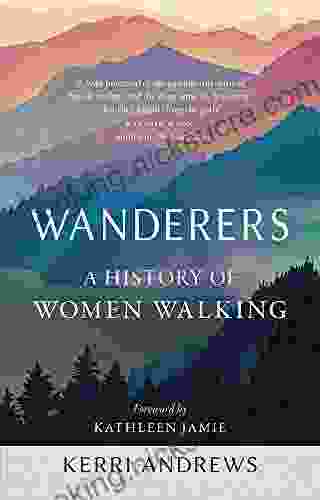Wanderers: A Comprehensive History of Women's Walking

Throughout history, women have faced numerous obstacles and barriers to their mobility and freedom. Walking, a seemingly simple and mundane activity, has often been a site of struggle and empowerment for women, as they have fought for the right to move freely and independently.
4.5 out of 5
| Language | : | English |
| File size | : | 476 KB |
| Text-to-Speech | : | Enabled |
| Screen Reader | : | Supported |
| Enhanced typesetting | : | Enabled |
| Word Wise | : | Enabled |
| Print length | : | 267 pages |
This comprehensive article will delve into the rich and multifaceted history of women's walking, exploring the challenges, milestones, and inspiring stories of women who have paved the way for female walkers throughout the ages.
Early History
In ancient societies, women's mobility was often restricted by cultural norms and social expectations. In many cultures, women were expected to stay close to home and were forbidden from traveling alone. However, there are isolated examples of women who defied these restrictions and embarked on extraordinary journeys.
One such example is the story of Hatshepsut, the female pharaoh of Egypt who ruled from 1479 to 1458 BCE. Hatshepsut was a skilled hiker and often led expeditions to distant parts of her kingdom. She also commissioned the construction of a series of temples and monuments, including the Mortuary Temple of Hatshepsut at Deir el-Bahari, which features reliefs depicting her hiking and climbing.
Another notable figure from ancient history is Artemisia I of Caria, who ruled from 480 to 470 BCE. Artemisia was a renowned naval commander who led her own fleet in the Battle of Salamis against the Persians. She was known for her courage and strategic brilliance, and her story has inspired generations of female warriors and leaders.
The Middle Ages
During the Middle Ages, women's mobility was further restricted by the rise of Christianity. The Church preached that women should be submissive and obedient to their husbands, and that their place was in the home. As a result, women were often confined to the domestic sphere and were discouraged from traveling or engaging in any kind of public activity.
Despite these restrictions, there were still some women who managed to defy the social norms and pursue their passion for walking. One such woman was Egeria, a Spanish nun who lived in the 4th century CE. Egeria embarked on a pilgrimage to the Holy Land, and her detailed account of her journey provides valuable insights into the experiences of female travelers in the Middle Ages.
The Renaissance and Enlightenment
The Renaissance and Enlightenment periods brought about a gradual shift in attitudes towards women's mobility. Humanist scholars began to argue that women were capable of intellectual and physical achievement, and that they should be given the opportunity to pursue their interests.
One of the most famous women of the Renaissance was Christine de Pizan, a French poet and philosopher. De Pizan was a vocal advocate for women's rights, and she wrote extensively about the importance of education and freedom for women. She also wrote a book called "The City of Ladies," which featured a group of women who embark on a pilgrimage to a utopian city where they can live freely and independently.
The 19th and 20th Centuries
The 19th and 20th centuries witnessed a growing number of women challenging traditional gender roles and pushing for greater freedom and independence. This period saw the rise of the women's rights movement, and women began to demand the right to vote, to work, and to pursue their own interests.
One of the most important figures in the history of women's walking is Annie Smith Peck. Peck was an American mountaineer and explorer who became the first woman to climb Mount Huascarán in Peru in 1908. She also led expeditions to other mountains around the world, and her achievements helped to inspire a generation of female climbers.
Another notable figure from this period is Harriet Chalmers Adams. Adams was an American author, photographer, and activist who became the first woman to walk across the United States in 1915. Her journey took her from New York City to San Francisco, and she wrote a book about her experiences called "A Woman's Way Through Unknown Labrador."
Walking as a Feminist Act
In the late 20th century, walking emerged as a powerful feminist symbol. Women began to use walking as a way to reclaim public space and to challenge the male-dominated culture of the time. In 1971, a group of women in New York City organized the first Take Back the Night march, in which hundreds of women walked through the streets to protest violence against women.
Walking has also been used as a tool for social change and activism. In 1987, a group of women in the United Kingdom founded the Greenham Common Women's Peace Camp. The women walked to the Greenham Common airbase, where they held a protest against the deployment of nuclear weapons. The camp lasted for 19 years, and it became a symbol of women's resistance to war and violence.
Women's Walking Today
In the 21st century, women's walking continues to evolve and take on new meanings. Women are walking for health, fitness, adventure, and social change. There are now more women than ever before participating in walking events, such as marathons and ultramarathons.
One of the most visible examples of women's walking today is the annual Women's March. The first Women's March was held in Washington, D.C. in 2017, and it drew millions of participants. The march was organized to protest the election of Donald Trump, and it has since become a symbol of women's resistance to sexism, racism, and xenophobia.
The history of women's walking is a rich and complex one, filled with challenges, triumphs, and inspiring stories. Women have fought for the right to move freely and independently, and they have used walking as a tool for self-expression, social change, and activism.
Today, women continue to walk for a variety of reasons. They walk for health, fitness, adventure, and social change. They walk to challenge stereotypes, to reclaim public space, and to make their voices heard. The history of women's walking is a testament to the power of women to overcome adversity and to create a more just and equitable world.
- The History of Women's Walking
- Women's Walking Pioneers
- Women's Walking Timeline
- Women's Walking Advocacy
- Walking as a Feminist Act
4.5 out of 5
| Language | : | English |
| File size | : | 476 KB |
| Text-to-Speech | : | Enabled |
| Screen Reader | : | Supported |
| Enhanced typesetting | : | Enabled |
| Word Wise | : | Enabled |
| Print length | : | 267 pages |
Do you want to contribute by writing guest posts on this blog?
Please contact us and send us a resume of previous articles that you have written.
 Fiction
Fiction Non Fiction
Non Fiction Romance
Romance Mystery
Mystery Thriller
Thriller SciFi
SciFi Fantasy
Fantasy Horror
Horror Biography
Biography Selfhelp
Selfhelp Business
Business History
History Classics
Classics Poetry
Poetry Childrens
Childrens Young Adult
Young Adult Educational
Educational Cooking
Cooking Travel
Travel Lifestyle
Lifestyle Spirituality
Spirituality Health
Health Fitness
Fitness Technology
Technology Science
Science Arts
Arts Crafts
Crafts DIY
DIY Gardening
Gardening Petcare
Petcare Mason Deaver
Mason Deaver Erica Hoke
Erica Hoke Kelly Oliver
Kelly Oliver Joe Cavallaro
Joe Cavallaro Katharine B Soper
Katharine B Soper Tod Schimelpfenig
Tod Schimelpfenig Patrick W Galbraith
Patrick W Galbraith Michael Anderle
Michael Anderle Tillie Walden
Tillie Walden Namina Forna
Namina Forna Greg Ruth
Greg Ruth Suzy Ashworth
Suzy Ashworth Rupert Sheldrake
Rupert Sheldrake Gemma Rogers
Gemma Rogers Giada De Laurentiis
Giada De Laurentiis Mandy Baggot
Mandy Baggot Andrea Olson
Andrea Olson Rick Westhead
Rick Westhead Bisco Hatori
Bisco Hatori Andrew Duncan
Andrew Duncan Necoco
Necoco Elizabeth Clor
Elizabeth Clor Sandy Stott
Sandy Stott Maria Konnikova
Maria Konnikova Steven J Matthiesen
Steven J Matthiesen J E Lendon
J E Lendon Thomas S Kuhn
Thomas S Kuhn Steven M Fiser
Steven M Fiser Walter Greiner
Walter Greiner Nancy B Rapoport
Nancy B Rapoport Gwendolyn Griffith Lieuallen
Gwendolyn Griffith Lieuallen Andrea Flores
Andrea Flores Marissa Meyer
Marissa Meyer Kiersten White
Kiersten White Tamara Ireland Stone
Tamara Ireland Stone Richard Heinberg
Richard Heinberg Leigh Bardugo
Leigh Bardugo Marcus A Pfeiffer
Marcus A Pfeiffer Kristine Papin Morris
Kristine Papin Morris George E P Box
George E P Box Andrea Hudy
Andrea Hudy April Vahle Hamel
April Vahle Hamel Meiso
Meiso Steven Johnson
Steven Johnson Lisa Bond
Lisa Bond Joe Posnanski
Joe Posnanski Mark M Meerschaert
Mark M Meerschaert Future Publishing
Future Publishing Mark Hume
Mark Hume Loren Pope
Loren Pope Peter David
Peter David Sara Manning Peskin
Sara Manning Peskin Dot Edu
Dot Edu Zak Mt Standridge
Zak Mt Standridge Jack Hunnicutt
Jack Hunnicutt Robin Satty
Robin Satty Thomas Meyer
Thomas Meyer W J Hendry
W J Hendry Stephan J Guyenet
Stephan J Guyenet Marta Szabo
Marta Szabo M D Johnson
M D Johnson Gary Thomas
Gary Thomas Paulette F C Steeves
Paulette F C Steeves Seth Reichelson
Seth Reichelson Susanna Kearsley
Susanna Kearsley Bruce D Perry
Bruce D Perry Margaret Thorsborne
Margaret Thorsborne Jeremy Freese
Jeremy Freese Jaak Panksepp
Jaak Panksepp Paul Rooyackers
Paul Rooyackers Andrew Blauner
Andrew Blauner Brock Eide
Brock Eide Deaver Brown
Deaver Brown Jenn Brandt
Jenn Brandt Hugh Raffles
Hugh Raffles James Rebanks
James Rebanks Jason Louv
Jason Louv Andrew St Pierre White
Andrew St Pierre White Rachel Hawkins
Rachel Hawkins Shane Ryan
Shane Ryan Lars Muhl
Lars Muhl Rachael Chapman
Rachael Chapman David Montgomery
David Montgomery Kirby Arnold
Kirby Arnold Wildlife Trusts
Wildlife Trusts James Dodson
James Dodson Andrew Greiner
Andrew Greiner Jennifer L Armentrout
Jennifer L Armentrout Hampton Sides
Hampton Sides Sue Fierston
Sue Fierston Mara Rockliff
Mara Rockliff C L Werner
C L Werner Mike Cyra
Mike Cyra Tim Wharnsby
Tim Wharnsby Laura Domino
Laura Domino Course Hero
Course Hero Denise Riebe
Denise Riebe Whitney Nelson
Whitney Nelson Linda Eyre
Linda Eyre Rashers Tierney
Rashers Tierney Jenna Miscavige Hill
Jenna Miscavige Hill Rashid Khalidi
Rashid Khalidi Kerri Andrews
Kerri Andrews Jennifer Blair
Jennifer Blair Prasad Raju V V N R Pathapati
Prasad Raju V V N R Pathapati Kenneth S Shultz
Kenneth S Shultz Neil Oliver
Neil Oliver Rob Taylor
Rob Taylor Charlotte Elkins
Charlotte Elkins Geoffrey Wolff
Geoffrey Wolff Milo Stewart
Milo Stewart Tracy Townsend
Tracy Townsend Jacqueline Edmondson
Jacqueline Edmondson Steve Scott
Steve Scott Sorin Dumitrascu
Sorin Dumitrascu Thomas Berger
Thomas Berger George Mahood
George Mahood David Borgenicht
David Borgenicht Jon Gillespie Brown
Jon Gillespie Brown Brad Schoenfeld
Brad Schoenfeld Andrew Feinberg
Andrew Feinberg Michael Hermann
Michael Hermann David Alloway
David Alloway Frans De Waal
Frans De Waal Isabel Sterling
Isabel Sterling Bob Mayer
Bob Mayer Nancy Mather
Nancy Mather Robin Hobb
Robin Hobb Richard Maury
Richard Maury Robert B Yonaitis
Robert B Yonaitis Kailin Gow
Kailin Gow Matt Fulks
Matt Fulks Richard N Aufmann
Richard N Aufmann Andy Bull
Andy Bull Vin T Sparano
Vin T Sparano Stephanie Cacioppo
Stephanie Cacioppo Steve Bisheff
Steve Bisheff Stephen Chbosky
Stephen Chbosky Dana Mccullough
Dana Mccullough Rizwan Virk
Rizwan Virk Greg Presto
Greg Presto Kristin Briney
Kristin Briney Robert Jay Lifton
Robert Jay Lifton Joseph Luzzi
Joseph Luzzi Christina Kim
Christina Kim Paul Kalas
Paul Kalas Julie Powers
Julie Powers Arlo Adams
Arlo Adams Riley Black
Riley Black Nikola Tesla
Nikola Tesla Clayton Everline
Clayton Everline Linda Anne Silvestri
Linda Anne Silvestri Lonely Planet
Lonely Planet A J Carlisle
A J Carlisle Andrew Brown
Andrew Brown Melissa Caughey
Melissa Caughey Ben Doughty
Ben Doughty Kindra Gordon
Kindra Gordon Gaurav Suri
Gaurav Suri Jason Zemcik
Jason Zemcik Gabby Rivera
Gabby Rivera Bobby Orr
Bobby Orr Patrick Hatt
Patrick Hatt Steven Arms
Steven Arms Luke Hohmann
Luke Hohmann E K Johnston
E K Johnston Andrea Wachter
Andrea Wachter Ed Willes
Ed Willes Dr Gabriel Peter Salgo
Dr Gabriel Peter Salgo Arianna Astuni
Arianna Astuni David Abram
David Abram Nathaniel Philbrick
Nathaniel Philbrick Serena Valentino
Serena Valentino Will Thornton
Will Thornton Guillermo Ferrara
Guillermo Ferrara Michio Kaku
Michio Kaku C L Mississippi Morgan
C L Mississippi Morgan Tom Lecompte
Tom Lecompte Connie J Wells
Connie J Wells Galen Wolf
Galen Wolf Jen Calonita
Jen Calonita Kelly Tyler Lewis
Kelly Tyler Lewis V E Schwab
V E Schwab Andrej Spec
Andrej Spec Kelsie Stelting
Kelsie Stelting Lena Shev
Lena Shev Department Of Defense
Department Of Defense Andrew Doughty
Andrew Doughty Marcus Felson
Marcus Felson Lilith Starr
Lilith Starr Carmen Micsa
Carmen Micsa Jay Greeson
Jay Greeson Jed Z Buchwald
Jed Z Buchwald Usa Pickleball Association
Usa Pickleball Association Ian Tattersall
Ian Tattersall James Geary
James Geary James Fox
James Fox Kyle Keegan
Kyle Keegan Jim Apfelbaum
Jim Apfelbaum Noel Janis Norton
Noel Janis Norton Ann Gadzikowski
Ann Gadzikowski James Branch Cabell
James Branch Cabell Joseph Bruchac
Joseph Bruchac Victoria Allman
Victoria Allman Emily Henry
Emily Henry Janet Wolanin Alexander
Janet Wolanin Alexander Nic Oatridge
Nic Oatridge Pat Wray
Pat Wray Ben Orlin
Ben Orlin Luigi Gabriele Conti
Luigi Gabriele Conti Leslie Vedder
Leslie Vedder Jack Purdum
Jack Purdum Kevin Cook
Kevin Cook Wolfgang Hohlbein
Wolfgang Hohlbein Shaun Assael
Shaun Assael Pietro Matracchi
Pietro Matracchi Richard P Feynman
Richard P Feynman Michele Leathers
Michele Leathers Sarah Castille
Sarah Castille Jennifer Anne Davis
Jennifer Anne Davis Doug Swisher
Doug Swisher Catherine Montgomery
Catherine Montgomery Dylan Norton
Dylan Norton Bridget Portmann
Bridget Portmann Susan Williams White
Susan Williams White Steve Sheinkin
Steve Sheinkin Jakub Marian
Jakub Marian Mary Jane Sterling
Mary Jane Sterling Andrew Beyer
Andrew Beyer Andrea Curtis
Andrea Curtis Stuart L Kaplan M D
Stuart L Kaplan M D Craig Custance
Craig Custance Vertamae Smart Grosvenor
Vertamae Smart Grosvenor David W Brown
David W Brown Joseph Ledoux
Joseph Ledoux Victoria Schwab
Victoria Schwab Charles Szypszak
Charles Szypszak Sid Thatte
Sid Thatte Brandon Mull
Brandon Mull George Hospodar
George Hospodar Cathal Armstrong
Cathal Armstrong Nick Marshall
Nick Marshall Ronald W Doerfler
Ronald W Doerfler Antonio Iturbe
Antonio Iturbe Kathleen Dean Moore
Kathleen Dean Moore Melissa Reynolds
Melissa Reynolds Marta Obiols Llistar
Marta Obiols Llistar Bernard A Chavis
Bernard A Chavis Gabrielle Coleman
Gabrielle Coleman Catie Czora
Catie Czora Laurie Ann Thompson
Laurie Ann Thompson Joey Miller Msw Lcsw
Joey Miller Msw Lcsw Sudhir Shirwadkar
Sudhir Shirwadkar Daniel P Murphy
Daniel P Murphy Matt Richtel
Matt Richtel Metin Bektas
Metin Bektas Andrew Goliszek
Andrew Goliszek Kylie Lee Baker
Kylie Lee Baker Paul Abell
Paul Abell Lucia Ashta
Lucia Ashta Sheila Jasanoff
Sheila Jasanoff Trish Allison
Trish Allison Bruce Bowlen
Bruce Bowlen Karen Tranberg Hansen
Karen Tranberg Hansen James Lyons Weiler
James Lyons Weiler Sarah Outen
Sarah Outen Peter Boardman
Peter Boardman Mira Kirshenbaum
Mira Kirshenbaum Patrick Mouratoglou
Patrick Mouratoglou Hayley Campbell
Hayley Campbell Carrie Ryan
Carrie Ryan Rajani Katta
Rajani Katta Daniel Humm
Daniel Humm Julie Miller
Julie Miller Jefferson Hawkins
Jefferson Hawkins Stan Tekiela
Stan Tekiela Richard Munson
Richard Munson Caren Van Slyke
Caren Van Slyke S Fatou
S Fatou Raymond E Feist
Raymond E Feist Ola Ola
Ola Ola Joseph Terry
Joseph Terry Charles H Hapgood
Charles H Hapgood Donna Bollinger
Donna Bollinger Mark Mcconville
Mark Mcconville Mara Vorhees
Mara Vorhees Rick Heard
Rick Heard Robin Ha
Robin Ha 18th Edition Kindle Edition
18th Edition Kindle Edition Kristen Thone
Kristen Thone Brian C Muraresku
Brian C Muraresku Josh Tabor
Josh Tabor Rachel Meltzer Warren
Rachel Meltzer Warren Lori Shandle Fox
Lori Shandle Fox Jim Shea
Jim Shea Andrea Cremer
Andrea Cremer Anna Holmwood
Anna Holmwood Dorothy Pang
Dorothy Pang Raymond Coppinger
Raymond Coppinger Ricky Moore
Ricky Moore Ewen Levick
Ewen Levick James Mallory
James Mallory George Christian Pappas
George Christian Pappas Samantha Rodman
Samantha Rodman Tony Herman
Tony Herman Michael T Nygard
Michael T Nygard Roger Atwood
Roger Atwood Bruce Mcnall
Bruce Mcnall Eugene Raikhel
Eugene Raikhel Leslie Sokol
Leslie Sokol Anne Bogel
Anne Bogel Pete Pfitzinger
Pete Pfitzinger Nancy Mcwilliams
Nancy Mcwilliams Sean Pidgeon
Sean Pidgeon Christos Lynteris
Christos Lynteris Ronald D Davis
Ronald D Davis Jonathan Cummings
Jonathan Cummings Steven Poses
Steven Poses Dani Jacobs
Dani Jacobs Jim Curran
Jim Curran William Gerin
William Gerin H Spencer Lewis
H Spencer Lewis Martin Rooney
Martin Rooney D Harvey
D Harvey Patsy M Lightbown
Patsy M Lightbown Rita Jablonski
Rita Jablonski Kjartan Poskitt
Kjartan Poskitt Rolf Potts
Rolf Potts Elizabeth S Trafalgar
Elizabeth S Trafalgar Pliny The Elder
Pliny The Elder Rich Luhr
Rich Luhr William F Sensakovic
William F Sensakovic Steve Anthony Tallon
Steve Anthony Tallon Ian O Connor
Ian O Connor Eric Engle
Eric Engle Jeff Davis
Jeff Davis Andrea Gonzales
Andrea Gonzales Buster Benson
Buster Benson Anne Holler
Anne Holler Steven H Weintraub
Steven H Weintraub Benedict Carey
Benedict Carey Wendy Heard
Wendy Heard Jimmy Elliott
Jimmy Elliott Jonathan Clements
Jonathan Clements Andre Watson
Andre Watson Joelle Charbonneau
Joelle Charbonneau Peter Scazzero
Peter Scazzero Andrea Cataldo
Andrea Cataldo Donald S Murray
Donald S Murray Gregory Curtis
Gregory Curtis Richard Bellman
Richard Bellman 24th Edition Kindle Edition
24th Edition Kindle Edition Sameera Khan Rd Pa C
Sameera Khan Rd Pa C J David Logan
J David Logan Bettina Bonifatti
Bettina Bonifatti Becky Lomax
Becky Lomax Arous Brocken
Arous Brocken Garcilaso De La Vega
Garcilaso De La Vega Tom Lodziak
Tom Lodziak Frances Evesham
Frances Evesham Romney Steele
Romney Steele Terry Ann Williams Richard
Terry Ann Williams Richard Joe Wells
Joe Wells Christian Keur
Christian Keur Tom Siegfried
Tom Siegfried Bhavesh Mamtani
Bhavesh Mamtani Ralph Zuranski
Ralph Zuranski Gerald A Moore Sr
Gerald A Moore Sr Jamie Ivey
Jamie Ivey Robert H Miller
Robert H Miller Barbara Merry
Barbara Merry Candace Clark Trinchieri
Candace Clark Trinchieri Thomas Watson
Thomas Watson Robert Hamill
Robert Hamill Claire Maxted
Claire Maxted Mary Keith Piasecki
Mary Keith Piasecki Jason Welker
Jason Welker John Ramirez
John Ramirez Minal Hajratwala
Minal Hajratwala Victoria Ortiz
Victoria Ortiz Simon Garfield
Simon Garfield Rachel Atwood
Rachel Atwood Galit Shmueli
Galit Shmueli Laurie Seale
Laurie Seale Adam Mansbach
Adam Mansbach Jessica Mccrory Calarco
Jessica Mccrory Calarco Ronald J Harshbarger
Ronald J Harshbarger Lundy Bancroft
Lundy Bancroft Paco Underhill
Paco Underhill Robert Bacal
Robert Bacal Bill O Neill
Bill O Neill David Scott
David Scott Laird Hamilton
Laird Hamilton Ken Gullette
Ken Gullette Peter Mcbride
Peter Mcbride Jay Annelli
Jay Annelli Stephen Wiggins
Stephen Wiggins John Morton
John Morton John Bantin
John Bantin Leisy J Abrego
Leisy J Abrego Big Daddy Ozone
Big Daddy Ozone Tim Ryan
Tim Ryan William Ritter
William Ritter Timothy Johnson
Timothy Johnson James A Middleton
James A Middleton Bernard Craw
Bernard Craw Leslie Morgan Steiner
Leslie Morgan Steiner Brian Azzarello
Brian Azzarello Chiara Marletto
Chiara Marletto Lynne L Finch
Lynne L Finch Bernard Moitessier
Bernard Moitessier Roberto Pedreira
Roberto Pedreira Richard Bolstad
Richard Bolstad Robert Sky Allen Ph D
Robert Sky Allen Ph D Nick Peters
Nick Peters Erich Neumann
Erich Neumann Karen Robson
Karen Robson Andrea Bemis
Andrea Bemis Chris Salisbury
Chris Salisbury Keith Sutton
Keith Sutton Steve Caplin
Steve Caplin Paul Stamets
Paul Stamets Laura Lincoln Maitland
Laura Lincoln Maitland Marvin L Bittinger
Marvin L Bittinger Terence Callery
Terence Callery Bonita Norris
Bonita Norris Roland Martin
Roland Martin Andrew Gelman
Andrew Gelman Morihei Ueshiba
Morihei Ueshiba Aldous Huxley
Aldous Huxley Dayton O Hyde
Dayton O Hyde C B Lee
C B Lee Mike Gauthier
Mike Gauthier Christopher Sommer
Christopher Sommer Elizabeth S Meckes
Elizabeth S Meckes Brenda Reed Pilcher
Brenda Reed Pilcher Ryan Pellett
Ryan Pellett Jenny Mackay
Jenny Mackay Annette Curtis Klause
Annette Curtis Klause Harriet Brown
Harriet Brown Robyn Sheldon
Robyn Sheldon Christine Balaz
Christine Balaz Lauren Daniels
Lauren Daniels Francesca Zappia
Francesca Zappia Rob Summers
Rob Summers Chris Mcmullen
Chris Mcmullen James Turnbull
James Turnbull Daniel Shiffman
Daniel Shiffman Peter May
Peter May James Willstrop
James Willstrop Andrea Komlosy
Andrea Komlosy Robin Mamlet
Robin Mamlet James R Morrow Jr
James R Morrow Jr L Michele Issel
L Michele Issel Stacey Little
Stacey Little Ruby Walker
Ruby Walker Gillian Tett
Gillian Tett Cliff Wilson
Cliff Wilson Jordan Romero
Jordan Romero Anne Marie Meyer
Anne Marie Meyer Malinda Lo
Malinda Lo Ken Blanchard
Ken Blanchard Hasok Chang
Hasok Chang Oliver Perkins
Oliver Perkins Mike Davenport
Mike Davenport Christine Heppermann
Christine Heppermann Luke Rosiak
Luke Rosiak Kathryne Kennedy
Kathryne Kennedy James E Wisher
James E Wisher Baz Thompson
Baz Thompson Florent Buisson
Florent Buisson Elizabeth Marshall Thomas
Elizabeth Marshall Thomas Ivan Pastine
Ivan Pastine John Gilbert
John Gilbert Chris Lilly
Chris Lilly Michael S Malone
Michael S Malone Sunny Anderson
Sunny Anderson Michael Judge
Michael Judge Sandra Glosser
Sandra Glosser
Light bulbAdvertise smarter! Our strategic ad space ensures maximum exposure. Reserve your spot today!

 Milan KunderaUnlocking the Path to Energy Management Excellence: A Comprehensive Review of...
Milan KunderaUnlocking the Path to Energy Management Excellence: A Comprehensive Review of...
 Robert Louis StevensonAn Integrative Program To Understand And Manage Your BPD: New Harbinger Self
Robert Louis StevensonAn Integrative Program To Understand And Manage Your BPD: New Harbinger Self Eugene ScottFollow ·11.6k
Eugene ScottFollow ·11.6k Beau CarterFollow ·11.6k
Beau CarterFollow ·11.6k Adam HayesFollow ·15.1k
Adam HayesFollow ·15.1k Elias MitchellFollow ·7.3k
Elias MitchellFollow ·7.3k Frank MitchellFollow ·11.1k
Frank MitchellFollow ·11.1k Henry HayesFollow ·4.1k
Henry HayesFollow ·4.1k Dominic SimmonsFollow ·8.9k
Dominic SimmonsFollow ·8.9k Michael CrichtonFollow ·13.8k
Michael CrichtonFollow ·13.8k

 Demetrius Carter
Demetrius CarterGolf Scrimmages: Realistic Practice Games Under Pressure
Golf scrimmages are...

 Andres Carter
Andres CarterAhsoka Tano: The Force-Wielding Togruta Who Shaped the...
Ahsoka Tano is one of the most...

 Greg Foster
Greg FosterUndeath Ascendant: A Blood-Soaked Literary Odyssey into...
Immerse yourself in a macabre tapestry of...

 Paulo Coelho
Paulo CoelhoHow an English Polymath and French Polyglot Discovered...
The Rosetta Stone is...
4.5 out of 5
| Language | : | English |
| File size | : | 476 KB |
| Text-to-Speech | : | Enabled |
| Screen Reader | : | Supported |
| Enhanced typesetting | : | Enabled |
| Word Wise | : | Enabled |
| Print length | : | 267 pages |












